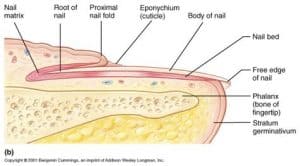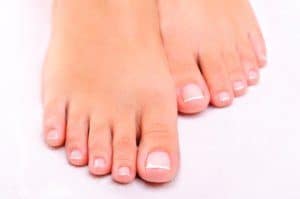Toenail Fungus and Anatomy

Toenail Fungus and Anatomy
Understanding the Toe: normal toenail anatomy and common nail disorders
 Both toenails, fingernails and hair are made from keratin, a type of structural protein. As a protein, keratin is unique and differs greatly from the proteins which make up muscle tissue. This substance is indigestible, hard, shiny, and unusually durable.
Both toenails, fingernails and hair are made from keratin, a type of structural protein. As a protein, keratin is unique and differs greatly from the proteins which make up muscle tissue. This substance is indigestible, hard, shiny, and unusually durable.
The specialized cells which create keratin are found at the base of the nails and within hair follicles. As these cells multiply, more keratin is deposited in layers and hardens almost instantly. At a steady, predictable rate the corresponding hair and nails grow.
Note that the characteristics of the final nail can vary considerably. Traits such as growth rate, strength, and nail stiffness are largely due to heredity. As such, several relatively common podiatric conditions are influenced by these various growth tendencies.

The following structures and functions correspond to the 6 different regions of the nail.
1. The nail matrix: this refers to the living, biologically active part of the nail. The toenail matrix is responsible for producing structural units formed from the protein keratin. As new nail material is added it pushes the existing material forward, forcing the nail to lengthen.
2. The nail plate: this is the technical term for the nail itself.
3. The nail bed: the portion of living skin tissue beneath the nail plate.
4. The lunula: this is the small moon-shaped crescent which appears at the base of the plate. It’s normally a lighter color and may appear entirely white.
5. Nail folds: these specialized grooves hold the nail in place against the skin as it grows.
6. The nail cuticle: this refers to the thin layer of tissue which collects at the margins of the nails as they grow from the skin.
Common growth problem—toenails which grow upwards:
Due to their natural shape human toenails almost always grow downwards. The reverse can occur as well, however, and is simply known as a vertical nail. This can occur for a variety of reasons:
- A patient’s genetically determined growth pattern.
- Poorly fitting footwear, i.e. an overly tight toe-box.
- Chronic dampness caused by profuse foot sweating.
- As a result of injury.
Also note that several less-common conditions can result in the formation of a vertical nail.
Treating vertical toenails
You should consult a podiatrist when you first begin to believe that your nails aren’t growing in normally. He or she will be able to determine if you’ve got onychogryphosis, koilonychia, NPS, or another nail condition.
Regardless of your doctor’s findings it’s essential for patients to maintain proper foot hygiene and nail care. Vertical toenails tend to rip away more often which can open the gates for bacterial or fungal infections. The most important part is simply trimming the nails close using a clean, sharp clipper. Cut straight across—not curved—in order to prevent the nail from growing inward.
Always cut the nails when they are clean and dry as dry nails are less likely to crack. Other tips include:
- Inspect your nails at least once a week. You don’t necessarily need to clip them this often but by checking you can become aware of any ongoing changes.
- Use the other end of the clipper to scrape dirt out from under the nail.
- After cutting the nails wash the feet thoroughly with soap and warm water. Then towel dry.
- After bathing be sure to use a high quality moisturizing lotion on the feet. Massage into the nails and cuticle when applying.
- Smooth the rough edges of a freshly clipped nail using an emery board or file. This will prevent them from catching on socks or other clothing.
- Wear clean, dry socks and change at least once daily. Note that natural cotton socks are preferable as they wick away sweat more efficiently.
- Wear high quality, sports-specific footwear when active.
- Don’t go barefoot in warm, damp public places such as swimming pools and locker rooms. Wear sandals or flip-flops instead.
Toenail Fungus and Anatomy and Nail Diseases
Onychogryphosis:
This is a general term which refers to the thickening of the toenails. Causes vary by case, with injury and infection being the most common. All nails may be effected but the condition is most commonly seen on the big (1st) toe. Due to the resulting shape the condition is informally referred to as “ram’s horn nail” or “claw nail” by many clinicians.
Nail-patellar syndrome:
This genetic disorder is most often referred to simply as NPS. The severity of the condition runs a wide spectrum, and indeed all NPS patients present with some nail abnormalities. Those with more pronounced physical defects are also likely to experience abnormalities of the elbow, knee, and hip joints. Note that NPS patients are also at an increased risk of developing various kidney diseases.
Koilonychia
This deformity presents as overly thin, fragile nails with a distinctive spoon-shaped appearance. In the majority of cases koilonychia is thought to be genetic in origin. Iron deficiency (anemia), celiac disease, and hypothyroidism are also suspected causes. Patients with an iron-absorption disorder known as hemochromatosis also frequently develop koilonychia.
How does toenail fungus impact the nail plate’s thickness and texture?
Toenail fungus can have a significant impact on the thickness and texture of the nail plate. Here’s how it can affect them:
- Thickening of the nail:
Toenail fungus, medically known as onychomycosis, can cause the nail plate to thicken over time. The fungal infection can lead to an overgrowth of cells in the nail bed, resulting in thickening and distortion of the nail.
- Brittleness and fragility:
Infected nails may become brittle and prone to breakage. They can develop a crumbly or powdery texture, making them more susceptible to damage.
- Discoloration:
One common sign of toenail fungus is a change in nail color. The infected nail may appear yellow, brown, or white. In some cases, the nail may become darker or develop patches of discoloration.
- Irregular surface:
The presence of toenail fungus can cause the nail surface to become rough, uneven, and pitted. The nail may develop ridges, grooves, or indentations.
- Separation from the nail bed:
As the fungal infection progresses, the nail plate may start to separate from the underlying nail bed. This condition is known as onycholysis and can create a gap between the nail and the bed, leading to further changes in the nail’s texture and appearance.
Does toenail fungus affect the nail matrix, and if so, how?
Toenail fungus can indeed affect the nail matrix, which is the area at the base of the nail where new nail cells are produced. The fungal infection can invade and disrupt the nail matrix, leading to various changes in the growth and appearance of the nail. As the fungus spreads, it can impair the normal functioning of the nail matrix cells, resulting in abnormalities in nail growth and structure. This can manifest as thickened, discolored, or deformed nails.
If Your Nails Are Ugly, What Can You Do?
- Artificial Toenails – We can quickly apply realistic long lasting cosmetic toenails in the office with excellent results. The fake nails will grow out as your own nail does. Artificial toenails in Cranberry Twp can be “filled ” in after several months.
- L
